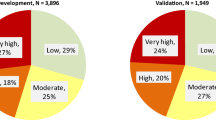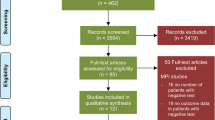Abstract
Background
Prevention and development of diagnostic and therapeutic techniques reduced morbidity and mortality for coronary artery disease (CAD). In this context, the cardiovascular risk assessment for major adverse cardiac events (MACE) at 2-year (CRAX2MACE) model for prediction of 2-year major adverse cardiac events was developed. We performed an external validation of this model.
Methods
We included 1003 patients with suspected CAD undergoing stress-rest single-photon emission computed tomography myocardial perfusion imaging at our academic center between March 2015 and April 2019.
Results
Considering the occurrence of MACE (death from any cause, acute myocardial infarction, or late coronary revascularization), for the CRAX2MACE model the area under the receiver operating characteristic curve was 0.612 and the Brier score was 0.061. The Hosmer–Lemeshow test estimated a non-optimal fit (χ2 28, P < .001). Considering only hard events (cardiac death, acute myocardial infarction), the external validation of the CRAX2MACE model revealed a Brier score of 0.053 and an area under the receiver operating characteristic curve of 0.621. Hosmer–Lemeshow test was calculated by deciles and showed a poor fit (χ2 31, P < .001).
Conclusion
CRAX2MACE model had a limited value for predicting 2-year major adverse cardiovascular events in an external validation cohort of patients with suspected CAD.


Similar content being viewed by others
Abbreviations
- MPS:
-
Single-photon emission computed tomography myocardial perfusion imaging
- CAD:
-
Coronary artery disease
- MACE:
-
Major adverse cardiac events
- LV:
-
Left ventricular
- TPD:
-
Total perfusion defect
- TID:
-
Transient ischemic dilatation
- CRAX2MACE:
-
Cardiovascular risk assessment for MACE at 2 years
- IQR:
-
Interquartile range
- CI:
-
Confidence interval
- AUROC:
-
Area under receiver operating characteristic
References
Piepoli MF, Hoes AW, Agewall S, Albus C, Brotons C, Catapano AL. 2016 European Guidelines on cardiovascular disease prevention in clinical practice: The Sixth Joint Task Force of the European Society of Cardiology and Other Societies on Cardiovascular Disease Prevention in Clinical Practice (constituted by representatives of 10 societies and by invited experts) developed with the special contribution of the European Association for Cardiovascular Prevention & Rehabilitation (EACPR). Eur Heart J 2016;37:2315‐81.
Mensah GA, Wei GS, Sorlie PD, Fine LJ, Rosenberg Y, Kaufmann PG, et al Decline in cardiovascular mortality: Possible causes and implications. Circ Res 2017;120:366‐80.
Rozanski A, Gransar H, Hayes SW, Min J, Friedman JD, Thomson LE, et al Temporal trends in the frequency of inducible myocardial ischemia during cardiac stress testing: 1991 to 2009. J Am Coll Cardiol 2013;61:1054‐65.
Duvall WL, Rai M, Ahlberg AW, O’Sullivan DM, Henzlova MJ. A multi-center assessment of the temporal trends in myocardial perfusion imaging. J Nucl Cardiol 2015;22:539‐51.
Thompson RC, Allam AH. More risk factors, less ischemia, and the relevance of MPI testing. J Nucl Cardiol 2015;22:552‐4.
Jouni H, Askew JW, Crusan DJ, Miller TD, Gibbons RJ. Temporal trends of single-photon emission computed tomography myocardial perfusion imaging in patients without prior coronary artery disease: A 22-year experience at a tertiary academic medical center. Am Heart J 2016;176:127‐33.
Jouni H, Askew JW, Crusan DJ, Miller TD, Gibbons RJ. Temporal trends of single-photon emission computed tomography myocardial perfusion imaging in patients with coronary artery disease: A 22-year experience from a tertiary academic medical center. Circ Cardiovasc Imaging 2017;10:e005628.
Megna R, Zampella E, Assante R, Nappi C, Gaudieri V, Mannarino T, et al Temporal trends of abnormal myocardial perfusion imaging in a cohort of Italian subjects: Relation with cardiovascular risk factors. J Nucl Cardiol 2020;27:2167‐77.
Leslie WD, Bryanton M, Goertzen A, Slomka P. Prediction of 2-year major adverse cardiac events from myocardial perfusion scintigraphy and clinical risk factors. J Nucl Cardiol 2021. https://doi.org/10.1007/s12350-021-02617-7.
Megna R, Petretta M, Alfano B, Cantoni V, Green R, Daniele S, et al A new relational database including clinical data and myocardial perfusion imaging findings in coronary artery disease. Curr Med Imaging Rev. 2019;15:661‐71.
Verberne HJ, Acampa W, Anagnostopoulos C, Ballinger J, Bengel F, De Bondt P, et al EANM procedural guidelines for radionuclide myocardial perfusion imaging with SPECT and SPECT/CT: 2015 revision. Eur J Nucl Med Mol Imaging 2015;2015:1929‐40.
Berman DS, Abidov A, Kang X, Hayes SW, Friedman JD, Sciammarella MG, et al Prognostic validation of a 17-segment score derived from a 20-segment score for myocardial perfusion SPECT interpretation. J Nucl Cardiol 2004;11:414‐23.
Martineau P, Slomka P, Goertzen A, Leslie WD. CRAX: A simple cardiovascular risk assessment tool to predict risk of acute myocardial infarction or death. J Nucl Cardiol 2018;27:2365‐74.
Hosmer DW, Lemesbow S. Goodness of fit tests for the multiple logistic regression model. Commun Stat Theory Methods 1980;9:1043‐69.
Diamond GA, Forrester JS. Analysis of probability as an aid in the clinical diagnosis of coronary-artery disease. N Engl J Med 1979;300:1350‐8.
Gibbons RJ, Miller TD. Declining accuracy of the traditional Diamond-Forrester estimates of pretest probability of coronary artery disease: Time for new methods. JAMA Intern Med 2021;181:579‐80.
Genders TS, Steyerberg EW, Alkadhi H, Leschka S, Desbiolles L, Nieman K, et al A clinical prediction rule for the diagnosis of coronary artery disease: Validation, updating, and extension. Eur Heart J 2011;32:1316‐30.
Genders TS, Steyerberg EW, Hunink MG, Nieman K, Galema TW, Mollet NR, et al Prediction model to estimate presence of coronary artery disease: Retrospective pooled analysis of existing cohorts. BMJ 2012;344:e3485.
Megna R, Assante R, Zampella E, Gaudieri V, Nappi C, Cuocolo R, et al Pretest models for predicting abnormal stress single-photon emission computed tomography myocardial perfusion imaging. J Nucl Cardiol 2019. https://doi.org/10.1007/s12350-019-01941-3.
Reeh J, Therming CB, Heitmann M, Højberg S, Sørum C, Bech J, et al Prediction of obstructive coronary artery disease and prognosis in patients with suspected stable angina. Eur Heart J 2019;40:1426‐35.
Boden WE, O’Rourke RA, Teo KK, Hartigan PM, Maron DJ, Kostuk WJ, et al Optimal medical therapy with or without PCI for stable coronary disease. N Engl J Med 2007;356:1503‐16.
Stone NJ, Grundy SM. The 2018 AHA/ACC/Multi-Society Cholesterol guidelines: Looking at past, present and future. Prog Cardiovasc Dis 2019;62:375‐83.
Petretta M, Cuocolo A. Comparison of ESC and ACC/AHA guidelines for myocardial revascularization: Are the differences clinically relevant? The European perspective. J Nucl Cardiol 2017;24:1057‐61.
Genders TSS, Coles A, Hoffmann U, Patel MR, Mark DB, Lee KL, et al The external validity of prediction models for the diagnosis of obstructive coronary artery disease in patients with stable chest pain: Insights from the promise trial. JACC Cardiovasc Imaging 2018;11:437‐46.
Ramspek CL, Jager KJ, Dekker FW, Zoccali C, van Diepen M. External validation of prognostic models: What, why, how, when and where? Clin Kidney J 2020;14:49‐58.
Disclosures
R. Megna, M. Petretta, R. Assante, E. Zampella, C. Nappi, V. Gaudieri, T. Mannarino, R. Green, V. Cantoni R. Green, A. D’Antonio, P. Buongiorno, W. Acampa, and A. Cuocolo declare that they have no conflict of interest.
Author information
Authors and Affiliations
Corresponding author
Additional information
Publisher's Note
Springer Nature remains neutral with regard to jurisdictional claims in published maps and institutional affiliations.
The authors of this article have provided a PowerPoint file, available for download at SpringerLink, which summarizes the contents of the paper and is free for re-use at meetings and presentations. Search for the article DOI on SpringerLink.com.
The authors have also provided an audio summary of the article, which is available to download as ESM, or to listen to via the JNC/ASNC Podcast.
Supplementary Information
Below is the link to the electronic supplementary material.
Rights and permissions
About this article
Cite this article
Megna, R., Petretta, M., Assante, R. et al. External validation of the CRAX2MACE model in an Italian cohort of patients with suspected coronary artery disease undergoing stress myocardial perfusion imaging. J. Nucl. Cardiol. 29, 2967–2973 (2022). https://doi.org/10.1007/s12350-021-02855-9
Received:
Accepted:
Published:
Issue Date:
DOI: https://doi.org/10.1007/s12350-021-02855-9




